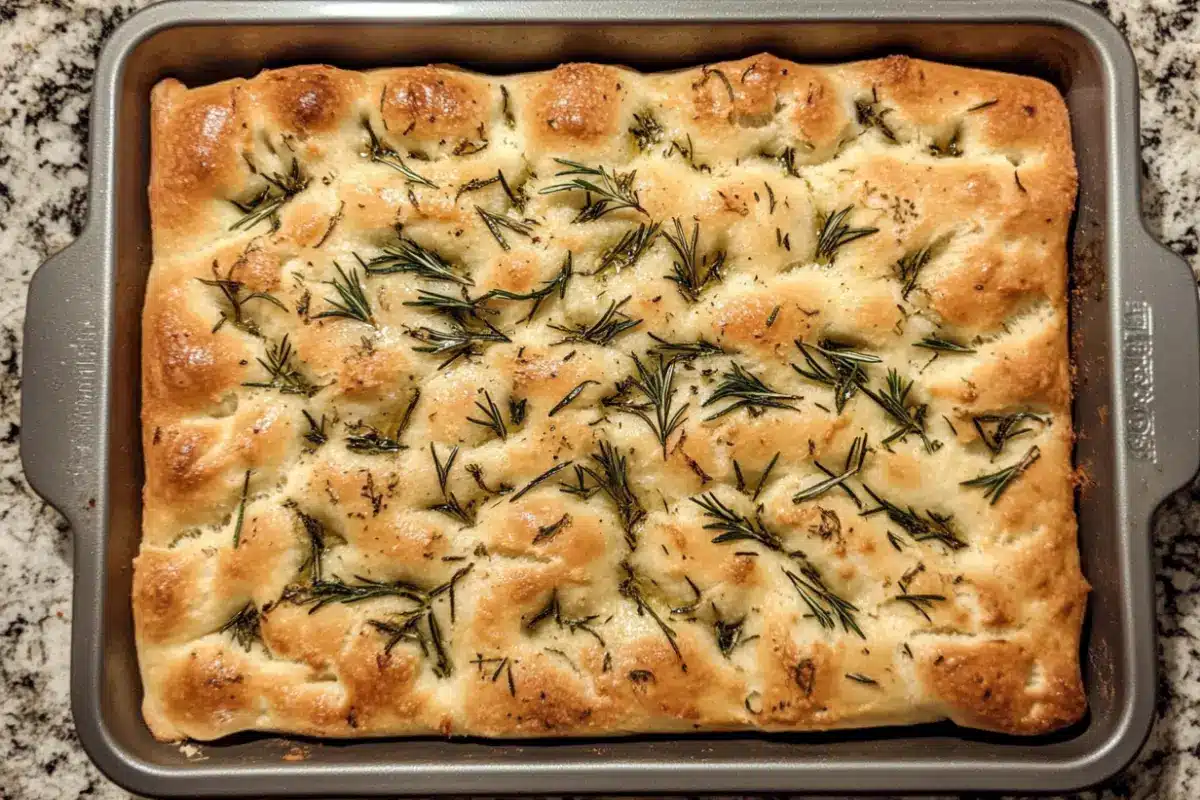Rosemary focaccia bread is a savory, aromatic Italian bread that’s deliciously soft on the inside with a golden, crispy crust. Infused with olive oil and fresh rosemary, this bread’s flavor and texture make it a versatile addition to any meal. Perfect as a side dish, sandwich base, or even a snack on its own, rosemary focaccia is both easy to make and incredibly satisfying.
This article covers everything you need to create the perfect rosemary focaccia bread, from choosing ingredients to baking tips, customizations, and serving suggestions.
Introduction
Focaccia is a traditional Italian flatbread that’s known for its olive oil-rich dough, dimpled top, and crunchy crust. The addition of rosemary gives this bread a fragrant, earthy note that perfectly complements its soft interior. Focaccia is often considered a staple in Italian households, served as an appetizer, alongside meals, or as a base for sandwiches.

The beauty of rosemary focaccia lies in its simplicity—using a few quality ingredients, you can create a flavorful, airy bread that’s versatile and impressive. Plus, the process of making focaccia is beginner-friendly, making it a great choice for both novice and experienced bakers.
Rosemary Focaccia Bread Ingredients Breakdown
Key Ingredients:
- Flour: All-purpose flour works well for focaccia, providing the right structure and texture. Bread flour can also be used for a chewier, more elastic dough.
- Yeast: Active dry yeast or instant yeast helps the dough rise, creating light and airy pockets. Fresh yeast can also be used, but the quantity may need adjusting.
- Olive Oil: Extra virgin olive oil is essential in focaccia, adding flavor, moisture, and a golden crust. Use a high-quality olive oil for the best taste.
- Salt: Salt enhances the bread’s flavor and balances the richness of the olive oil. Sea salt or kosher salt works well for sprinkling on top.
- Rosemary: Fresh rosemary leaves are aromatic and add an earthy flavor to the bread. Dried rosemary can be used in a pinch, but fresh is recommended.
- Warm Water: Water hydrates the dough, activating the yeast and helping the dough rise. It should be warm but not hot to avoid killing the yeast.
Optional Ingredients:
- Garlic: Finely minced garlic or garlic powder can be added to the dough or sprinkled on top for extra flavor.
- Parmesan Cheese: A sprinkle of grated Parmesan on top before baking adds a savory, nutty flavor and a touch of saltiness.
- Sea Salt Flakes: Large sea salt flakes sprinkled on top add a satisfying crunch and extra flavor.
- Cherry Tomatoes or Olives: Press halved cherry tomatoes or olives into the dough for a Mediterranean twist.
- Herbs: Other fresh herbs like thyme or oregano pair well with rosemary and add complexity to the flavor.
Step-by-Step Recipe Instructions
Rosemary Focaccia Bread Ingredients:
- 4 cups all-purpose flour
- 1 packet (2 1/4 tsp) active dry yeast
- 1 1/2 cups warm water
- 1/4 cup extra virgin olive oil (plus more for greasing and topping)
- 1 teaspoon salt
- 1 tablespoon fresh rosemary leaves, chopped
- Optional toppings: sea salt flakes, grated Parmesan, cherry tomatoes, or olives
Rosemary Focaccia Bread Instructions:
- Activate the Yeast: In a small bowl, dissolve the yeast in warm water (around 105°F to 110°F) and let it sit for 5-10 minutes until it becomes foamy.
- Make the Dough: In a large mixing bowl, combine the flour and salt. Pour in the activated yeast mixture and 2 tablespoons of olive oil. Stir until a rough dough forms.
- Knead the Dough: Transfer the dough to a lightly floured surface and knead for about 5-7 minutes until it becomes smooth and elastic.
- First Rise: Grease a large bowl with olive oil, place the dough inside, cover with a damp cloth, and let it rise in a warm place for 1-2 hours, or until it has doubled in size.
- Prepare the Baking Pan: Grease a baking sheet or baking pan with olive oil. Transfer the dough to the pan, gently stretching it to fit. Use your fingers to press dimples into the surface.
- Second Rise: Cover the dough and let it rise again for about 30-40 minutes until puffy.
- Top the Dough: Drizzle olive oil generously over the surface and sprinkle with chopped rosemary and sea salt flakes (and other toppings if desired).
- Bake: Preheat the oven to 400°F (200°C). Bake the focaccia for 20-25 minutes, or until it’s golden brown on top. Remove from the oven and let it cool slightly before slicing.
Tips for Perfecting Your Rosemary Focaccia Bread
- Use Fresh Rosemary: Fresh rosemary gives the best flavor and aroma. Dried rosemary can be used, but it won’t have the same fragrance.
- Create Dimples for Texture: Pressing dimples into the dough before baking traps oil and toppings, creating pockets of flavor and texture.
- Add Olive Oil Generously: Olive oil keeps the focaccia moist and flavorful. Be generous with it, both in the dough and on top.
- Don’t Skip the Second Rise: The second rise creates air pockets, making the bread light and airy. Letting it rise twice improves the final texture.
- Bake at a High Temperature: Baking at 400°F gives focaccia a crispy crust while keeping the inside soft and airy.
Variations and Customizations
- Garlic Rosemary Focaccia: Add minced garlic to the dough or sprinkle garlic powder on top before baking for an extra punch of flavor.
- Tomato Focaccia: Press halved cherry tomatoes into the dough for a burst of juiciness and color.
- Olive Focaccia: Add whole or sliced olives to the dough, creating a Mediterranean-inspired focaccia.
- Cheesy Focaccia: Sprinkle Parmesan or mozzarella cheese on top for a savory, cheesy twist.
- Herbed Focaccia: Mix fresh herbs like thyme, oregano, or basil with the rosemary for a more complex flavor.
- Stuffed Focaccia: Add fillings like caramelized onions or sun-dried tomatoes to the dough for a unique variation.
Rosemary Focaccia Bread Serving Suggestions
- As a Side Dish: Serve rosemary focaccia alongside soups, salads, or pasta dishes.
- Make a Focaccia Sandwich: Cut the bread in half and fill with your favorite ingredients like mozzarella, tomatoes, and basil for a hearty sandwich.
- With Dips: Serve warm focaccia with olive oil and balsamic vinegar, or spread it with hummus or pesto.
- Bread Basket: Include focaccia in a bread basket with other types of bread for a variety of textures and flavors.
- Breakfast Option: Top with scrambled eggs and avocado for a savory breakfast.
Storing and Reheating Leftovers
Storing:
- Room Temperature: Store leftover focaccia in an airtight container at room temperature for up to 2 days.
- Refrigerator: To keep it longer, wrap the bread tightly in plastic wrap or foil and refrigerate for up to a week.
- Freezer: Focaccia freezes well. Wrap in plastic wrap and aluminum foil, then freeze for up to 3 months. Thaw at room temperature before reheating.
Reheating:
- Oven: To reheat, wrap focaccia in foil and warm it in a 350°F oven for 10-15 minutes until heated through.
- Microwave: For a quick option, microwave individual slices for 10-15 seconds, though this can make it slightly chewy.
Health Benefits of Rosemary Focaccia
While focaccia is typically an indulgence, it does offer some health benefits, especially with the addition of rosemary and olive oil:
- Rich in Antioxidants: Olive oil is high in antioxidants and healthy fats, which support heart health.
- Anti-Inflammatory Properties: Rosemary contains antioxidants and compounds that may help reduce inflammation.
- Source of Fiber and Protein: Flour provides fiber and protein, especially if you use whole wheat or bread flour.
- Improved Digestion: Rosemary has been shown to aid digestion and may help with issues like indigestion or bloating.
- Supports Brain Health: Some studies suggest that rosemary may improve memory and concentration.
Rosemary Focaccia Bread Q&A
Q1: Can I use dried rosemary instead of fresh?
Yes, but fresh rosemary is more aromatic. Use about half the amount if substituting with dried rosemary.
Q2: What type of olive oil is best for focaccia?
Extra virgin olive oil provides the best flavor and richness, but you can use any olive oil you have on hand.
Q3: Can I make focaccia gluten-free?
Yes, a gluten-free flour blend can be used to make focaccia, though the texture may differ slightly.
Q4: Why does my focaccia not rise enough?
Ensure your yeast is fresh and allow the dough to rise in a warm environment. Cold temperatures or old yeast can inhibit rising.
Q5: How do I make the focaccia softer?
If you prefer a softer focaccia, bake it at a lower temperature (around 375°F) and reduce the baking time by a few minutes.
Conclusion
Rosemary focaccia bread is a delightful, versatile addition to any meal, with its aromatic flavor, soft texture, and crispy crust. Whether enjoyed on its own, as a side dish, or used in sandwiches, focaccia is a timeless favorite. With easy-to-follow instructions, customization options, and storage tips, this guide provides everything you need to make your own delicious rosemary focaccia at home.
Enjoy the satisfaction of baking from scratch and let the warm, earthy flavors of rosemary and olive oil fill your kitchen. Whether you’re a beginner or an experienced baker, this focaccia recipe is sure to become a staple in your kitchen. Happy baking!

